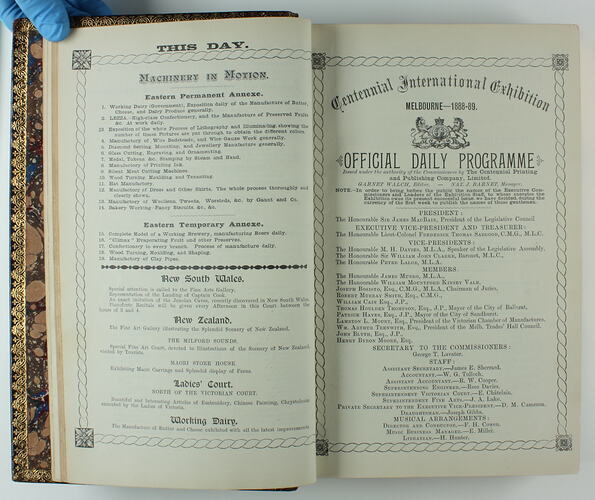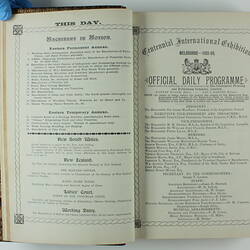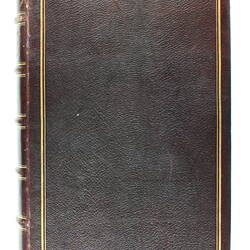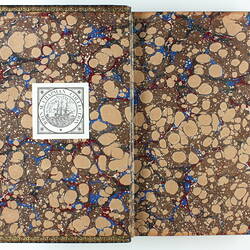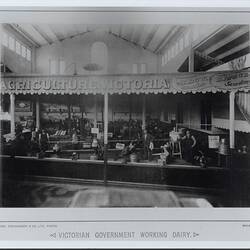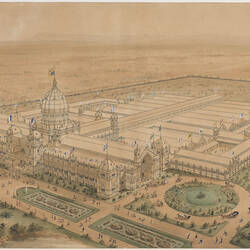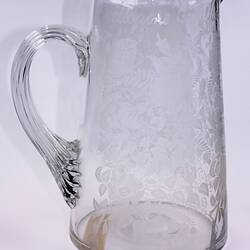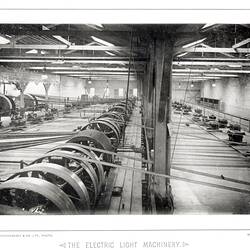Summary
This bound volume of daily programmes from the Melbourne Centennial International exhibition details the activities and events that took place at the exhibition in 1888-1889.
Overview
This bound daily volume of daily programmes from the Melbourne Centennial International Exhibition (MCIE) is an extremely rare object in Museums Victoria's collection.
The MCIE operated for a total of six months from the 1st August 1888 to the 2nd February 1889, Monday through to Saturday. During each day of the exhibition, a free programme of events and activities was printed on site at the Exhibition Building for visitors.
This leather bounded volume with gilt edges includes a total of 636 pages with 156 printed programmes, each being 4-5 pages long. Included in the programmes were demonstrations and musical performances for the day, as well as details and notifications for upcoming events. Timetables and schedules of what was being shown in particular courts and annexes were also included.
It also gives insight into the latest techonologies of the 19th century and provides information on musical trends and popularity at the time.
Courts and Annexes
Printed in the programme were the activities and events that mainly took place in the Victorian Court, the Victorian Annexes, the British Machinery Annexe, the New Zealand Court, the German Machinery Annexe, the German Court, the Northern Machinery Annexe, the South Australian Court, Minor Courts, activities in the Main Hall, activities in the Post Office Place, Activities at Gordon & Gotch's Newspaper Bureau, the Eastern Permanent Annexe, the Eastern Temporary Annexe, the Queensland Court, the Education Court and the French Machinery Court. Timetables and schedules of the events and activates taking place in these courts/annexes are printed and although some of the pages with these timetables are identical throughout the programme and are repeated every four pages, many have slight changes in times. The order in which each schedule is printed on a page also changes from time to time, which may indicate that particular annexes and courts had more to offer on particular days or it may simply be the rotation of advertising the variety of displays to visitors.
Events
The many annexes and courts at the 1888 MCIE displayed mineral, agricultural, pastoral, manufacturing, artistic and technological exhibits. The various activities, events and demonstrations at each exhibit range from singing lessons at the Education Court to jewellery manufacture and a biscuit factory at the Victorian Court to glass engraving at the British Court, and an electric light machine, the largest installation in the world at the Victorian Machinery Annexe, to name a few.
These daily events and activities ran from Monday through to Saturday, with the exhibition opening at 10:00am and closing at 10:30pm. Each event, activity and demonstration had their own open and closing times as for example, the model butter factory with 5 cream separators was open on Wednesdays, Thursdays, Fridays and Saturdays from 2:00pm to 4:00pm and on Saturday evenings from 7:00pm to 9:00pm.
Also included in this volume are programmes of choral and symphonic performances which were fascinating and are an important aspect of the exhibition as many of these musical performances had never before been seen in Melbourne. The programme records the types of pieces played that were written by various renowned composers, such as Wagner, Beethoven and Strauss, performed by Australian and international bands, artists and the MCIE choir. Some of the bands that were performing included the Premier City Military Band, Warnecke's Military Band, the Band of the 1st and 2nd Battalion, the Gordon Cadet Corps Band and the Carlton District Band.
Most interestingly, the programme provides information on musical trends and popularity. One example exists on page 407 where the number of people who voted for the orchestra to play particular musical works is revealed. The total number of papers sent in on the 17th and 24th of November was 1,066, with most voting for Wagner's Overture "Tannhauser" at 312 votes. Additionally, on Christmas day, the musical performances performed on this day give insight into popular Christmas hymns during the 19th Century.
The kinds of musical performances that were held at the MCIE were orchestral concerts, special orchestral concerts, Exhibition Popular concerts, Grand Choral concerts, pianoforte performances and daily organ recitals. The special orchestral concerts were held on Tuesday and Saturday afternoons at 3:30pm and on Tuesday evenings at 8:00pm. The Exhibition Popular concerts were held on Saturday evenings at 8:00pm and were of miscellaneous character which included ballads, while the Grand Choral concerts were held on Thursday evenings at 8:00pm.
However, sitting in on such events came at a cost. For the Exhibition Popular concerts, it cost three shillings to reserve a seat on the ground floor, for non-reserved seats on the ground floor the cost was two shillings and six pennies (2s, 6d), while to be seated in the galleries, the cost was one shilling (1s). Additionally, for the Grand Choral concerts, to reserve a seat on the ground floor would cost four shillings (4s), for non-reserved seats, two shillings and six pennies (2s, 6d) and again, for seating in the galleries it was to cost one shilling (1s). For the orchestral and special concerts, to reserve one of 300 premium seats on the ground floor, the cost was one shilling (1s) while all others were free. Admission for children to all concerts was half price, however children in the arms of their parents were not permitted. The audience was also politely requested to remain seated until the end of each performance.
Towards the end of the exhibition, visitors were able to enjoy free entertainments which included musical performances from bands, musical sketches, grand illuminations at the lake, entertainment with the use of props such as bottles, plates, globes and hats and bicyclist performances. These performances ran from the afternoon through to the evening.
Inaccuracies
There are a few errors within the programme with information that may have been printed incorrectly. For example, in programme 4, pages 18-20 have been repeated, along with programme 147 with pages 602-605 being repeated. There are also a few typing mistakes such as on page 347, where it states that the Jungfrau Kapelle Concert is to be performed Friday morning at 11:30pm, where it should be 11:30am.
References
Museums Victoria 2017, Bound Volume - Daily Programmes, Centennial International Exhibition, Melbourne, 1888-1889, retrieved 04 May 2017, .
Douglas, L 2008, Representing Colonial Australia at British, American and European International Exhibitions, ReCollections: Journal of the National Museum of Australia, vol. 3, no. 1, retrieved 04 May 2017, .
More Information
-
Keywords
-
Authors
-
Article types
